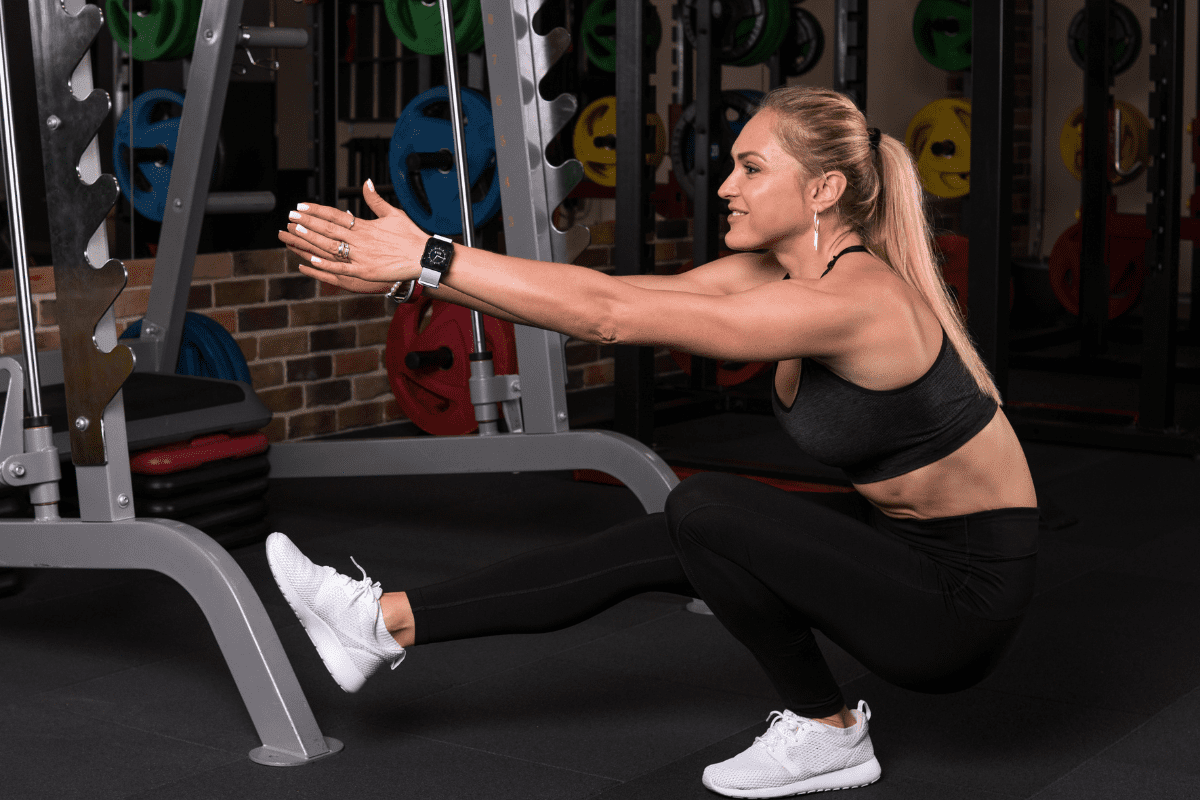10 Best Pistol Squat Alternatives for Single Leg Strength
I can totally relate to seeing someone do a full Pistol Squat on air and think, “No way I can do that.”
Which leads you here, to look for a Pistol Squat Alternative to use as a substitution.
Good news, you’re in the right place. First, I’m going to give you a couple of Pistol Squat variations that are much less intimidating and can be done by beginners. Next, I’m going to give you some completely different single-leg exercises that you can still use as an alternative.
Pistol Squat Modified Variations
First, the two modified Pistol Squats. One (or both) of these ideas might have you not needing a Pistol Squat alternative after all.
Pistol Squat to a Bench
Doing a Pistol Squat to a Bench would be my first suggestion for someone who isn’t ready to do a full unassisted Pistol Squat. This is also sometimes referred to as a Single Leg Box Squat.
Essentially, what you’re doing is lining yourself up right in front of a bench (or box) and with one foot up off the ground, slowly sitting down on the bench and then standing back up. If the bench is too low for you to stand back up, you can add a weight plate to make the surface a little taller.
Try to progress to where you can slowly lower yourself down, very lightly tap the bench with your butt and then stand tall. Once you can do that, stand on a weight plate to increase the range of motion.
I’ve seen countless athletes over the years that progressed to doing a full Pistol Squat through this same progression and just increasing the range of motion little by little until eventually… they didn’t need a bench at all.
Assisted Pistol Squat
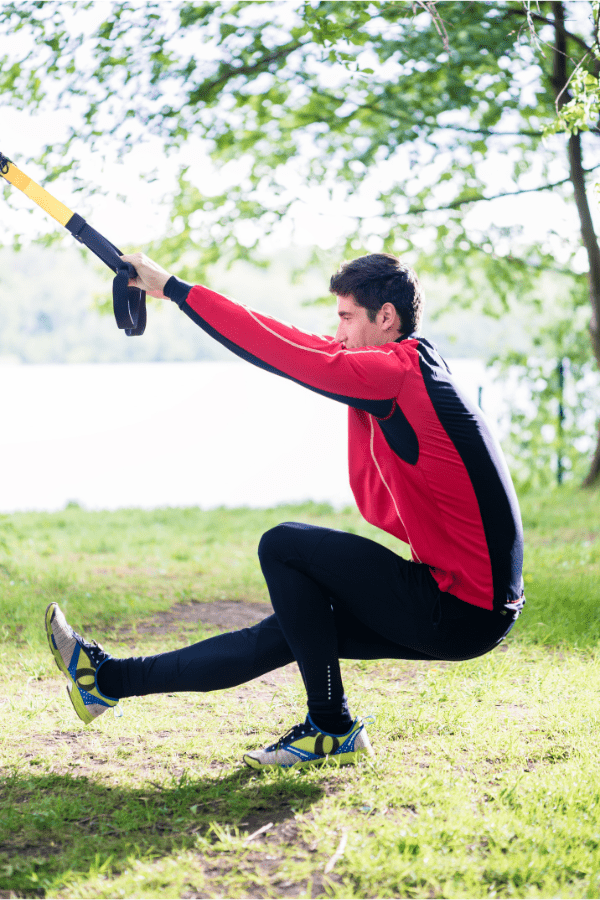
This is another Pistol Squat variation that makes the exercise accessible for beginners (I keep saying beginners but there are plenty of veteran lifters out there that can’t do a full Pistol Squat).
For this variation, you’ll need something to grab onto to help counterbalance yourself. A TRX Strap works perfectly, but Gym Rings or even a resistance band can do the trick as well.
Grab the strap, set yourself up and do a Pistol Squat. Hold onto the strap and use it to help you down slowly and then to help you back up. If you don’t feel comfortable going all the way down at first, that’s okay! Go down as low as you feel comfortable and then use the strap to help pull yourself back up.
Over time not only will you start to feel comfortable using more range of motion, but the amount that you need to use the strap for help will slowly diminish.
Best Pistol Squat Alternatives
Still wanting a different exercise? Don’t worry, I’ve got 8 of them to choose from. Some actually mimic Pistol Squats better than others, but all are solid single-leg exercises that will improve your lower body strength.
I’ve also added complete instructions on how to do each one so you can get started with one of them asap.
Single Leg Squat off Box
The elevated starting position demands less hamstring flexibility from the off leg which is an underestimated challenge of a Pistol Squat. It also is much easier to stay balanced.
You can control the range of motion by how high of a box you stand on and you can give yourself assistance by placing the box close to a rack that you can grab hold of if needed.
Equipment Needed
- An extremely stable box or bench
- A partner who will hold down the side of the box if needed as a counterweight.
Step-by-Step Instructions
- Stand tall with one leg down and the other straight drifting off the side of the box.
- Initiate the squat by hinging at the waist and bending at the knee simultaneously.
- Descend until the hip crease is just below the knee.
- Keep the heel flat and the center of mass over the mid-foot.
- Keep the torso as vertical as possible. Sometimes holding the arms straight out from here will help with balance and torso positioning.
- Once you reach depth, drive through the heel, keeping the foot flat, and stand tall.
Coaching Points
This is by far one of the most difficult variations of single-leg training. A proper progression needs to be followed in order to prepare the athlete for a movement like this.
Skater Squats
If you’re not quite ready for Pistol Squats, but you’re close, Skater Squats can be a good last stop before finally progressing onto Pistol Squats.
Equipment Needed
- None
Instructions
- Squeeze the shoulder blades and engage the lats to create a stable back to help with bracing the upper body
- Step backward with one leg, but do not place the foot back down on the ground.
- Instead, keep the chest as upright as possible and drop the back knee until it lightly touches the ground.
- Now drive through the heel and midfoot of the front foot to drive yourself back up tall.
- Repeat on the opposite leg and alternate back and forth until all reps have been completed.
Coaching Points (Fixes to Common Mistakes)
Keep the front foot flat on the floor when in the lunge position. One of the most common mistakes is raising up onto the ball of the front foot.
If you’re not able to do Skater Squats with good form, switch to a regular Reverse Lunge until you’re ready to do Skater Squats with proper form.
Bulgarian Split Squat
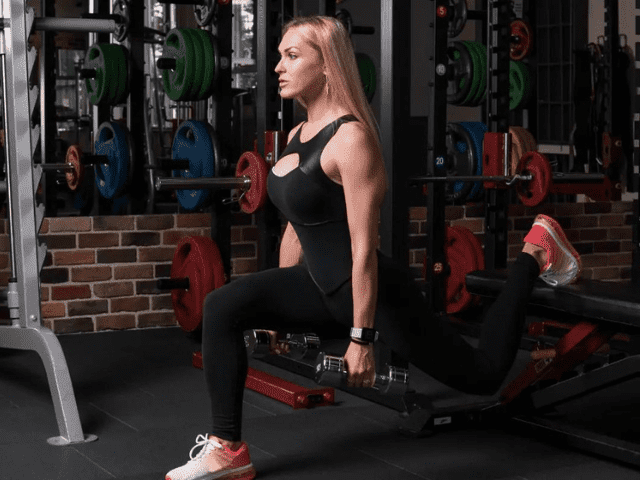
A Bulgarian Split Squat, also known as a Rear Foot Elevated Split Squat, is the last of the Pistol Squat alternatives that is a true single-leg exercise. What I mean by that is the opposite leg is in a position where it can’t really help drive yourself back up.
Up to this point, every exercise has been literally on one leg. A Bulgarian Split Squat involves putting your back foot up on a bench so while it can help balance it can’t really do much work (which is the point).
Note: This exercise can also be done with a barbell, but dumbbells are much safer in the event you lose your balance during a set.
Equipment Needed
- Dumbbells
- Bench, Box or Stack of Bumper Plates (essentially anything stable enough and tall enough to place your foot on)
Instructions
- Grab two dumbbells, one in each hand
- Get set up in front of your bench, reach one foot back and place it on the bench. Make sure you feel comfortable and balanced before proceeding.
- Squeeze the shoulder blades and engage the lats to create a stable back to help with bracing the upper body and to keep the dumbbells from swinging unnecessarily.
- Keep the chest as upright as possible and drop the back knee to roughly one inch from the floor.
- Now drive through the heel and midfoot of the front foot to drive yourself back up tall.
- Repeat until all reps are completed on that leg and then switch sides.
Coaching Points (Fixes to Common Mistakes)
When you step out, make sure to keep the feet shoulder-width apart. If you’re feeling very off-balance in your Bulgarian Split Squat there is a good chance that you are placing the lead foot directly in front of the back foot (essentially placing yourself on a tight rope).
Barbell Reverse Lunge
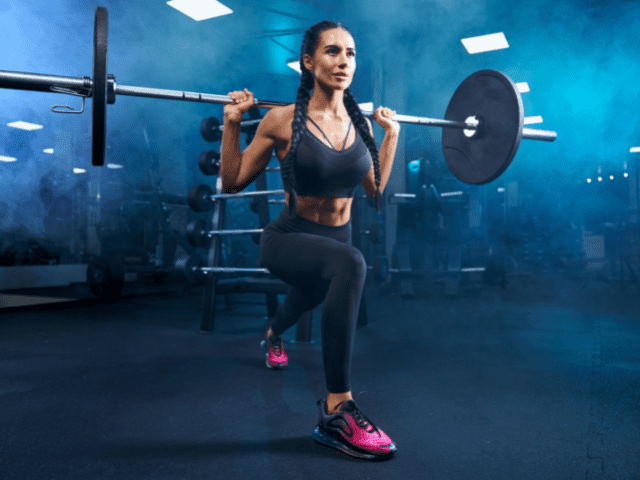
Barbell Reverse Lunge is a Pistol Squat alternative that involves having both feet on the ground during the drive phase. This means you’ll have to be intentional with driving off the proper leg during the movement.
Many athletes I’ve worked with find that reverse lunges can be easier on the knees than forward lunges. This is mostly due to removing the forward momentum that can shift the weight of the lunge from the hips toward the front knee.
Equipment Needed
- Barbell
- Bumper Plates (Iron Plates are fine as long as you’re not dropping the bar between sets)
- Squat Rack (Not completely necessary as you can clean and press a bar onto shoulders if needed, but a rack is going to make this a whole lot easier, especially if lifting heavier weight)
Instructions
- Unrack the barbell similar to how you would unrack a bar for a back squat.
- Grab the bar with a slightly wider than shoulder-width grip.
- Squeeze the shoulder blades and engage the lats to create a stable shelf to sit the bar on
- Place the bar across the traps, brace the core and remove the bar from the rack by standing tall and then walking back out of the rack.
- Once you’ve created enough room for yourself from the rack you can begin the movement.
- Step backward with one leg, giving yourself enough room to be able to drop into a lunge comfortably without feeling overextended.
- Keep the chest as upright as possible and drop the back knee to roughly one inch from the floor.
- Now drive through the heel and midfoot of the front foot to drive yourself back up tall.
- Repeat on the opposite leg and alternate back and forth until all reps have been completed.
Coaching Points
When you step back, make sure to keep the feet shoulder-width apart. If you’re feeling very off-balance in your lunge there is a good chance that you are stepping the lead foot directly behind the front foot (essentially placing yourself on a tight rope).
Dumbbell Lunge
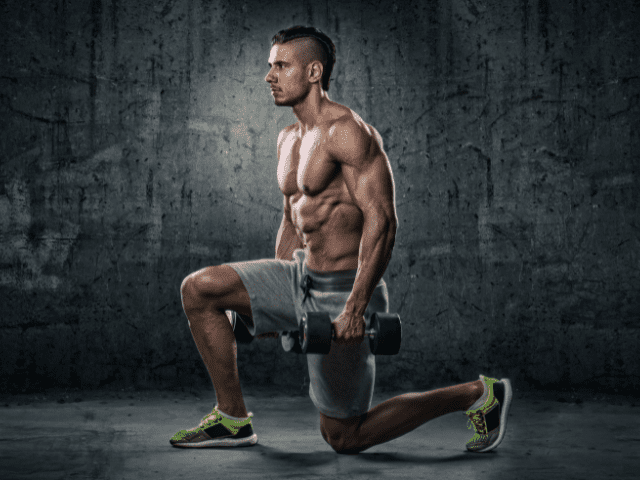
I’ve placed two lunge variations back to back here with Dumbbell Lunges and Barbell Reverse Lunges.
The truth is, you can use any variation you like the best. Lunge forward or backward. Or with a barbell or dumbbells. You can also lunge in place or do walking lunges across the gym. Find the variation that works best for you or mix it up every few workouts.
And while lunges may not be an exact replacement for Pistol Squats, they’re still a solid single-leg exercise.
Equipment Needed
- Dumbbells
Instructions
- Grab two dumbbells, one in each hand
- Squeeze the shoulder blades and engage the lats to create a stable back to help with bracing the upper body
- Once you’ve created enough room for yourself from the dumbbell rack (or wherever you pulled them from) you can begin the movement.
- Step forward with one leg, giving yourself enough room to be able to drop into a lunge comfortably without feeling overextended.
- Keep the chest as upright as possible and drop the back knee to roughly one inch from the floor.
- Now drive through the heel and midfoot of the front foot to drive yourself back up tall.
- Repeat on the opposite leg and alternate back and forth until all reps have been completed.
Coaching Points (Fixes to Common Mistakes)
When you step out, make sure to keep the feet shoulder-width apart. If you’re feeling very off-balance in your lunge there is a good chance that you are stepping the lead foot directly in front of the back foot (essentially placing yourself on a tight rope).
Dumbbell Step-Ups
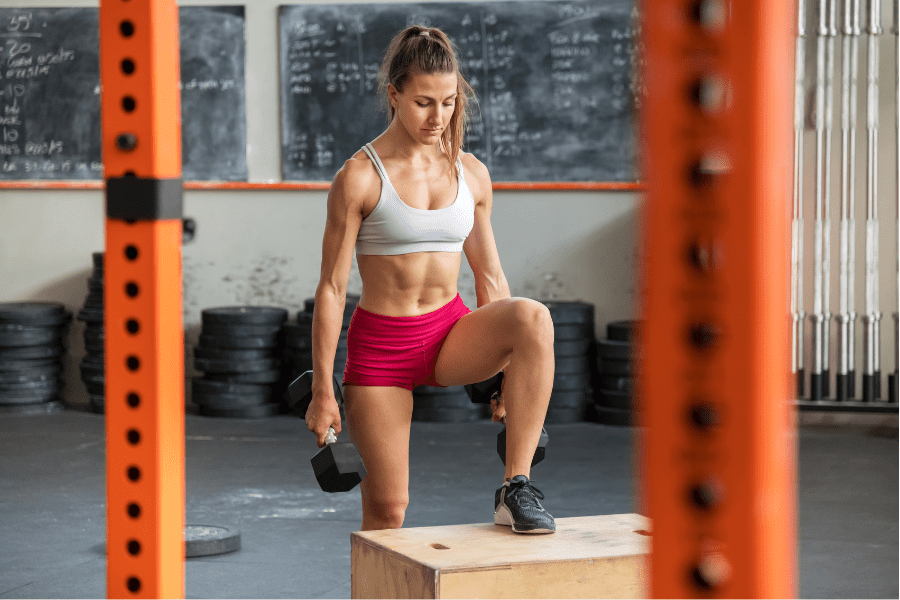
Dumbbell Step-Ups are another great single-leg exercise that can be used as an alternative to Pistol Squat. You can modify both the difficulty and the quad or hamstring emphasis by how tall of a box you use. (taller box will hit the hamstrings more).
Like Lunges, Step-ups can be done with dumbbells or a barbell.
Equipment Needed
- Dumbbells (Kettlebells can also be used if needed)
- A very stable surface to step up to. (Ideally, a box or bench that is stable, heavy, and well balanced)
Step-by-Step Instruction
- With the dumbbells at your side, hinge at the waist and bend your knees to lift. Keep a neutral spine as you are lifting the dumbbells. NEVER ROUND YOUR BACK WHILE LIFTING.
- Use a box height that is going to allow your hip and knee flexion to be as similar as possible to your stride while sprinting or bounding.
- Place one foot on the box, and drive the other leg’s knee up.
- The leg drive should be fast and explosive. (Quick note: keep the up leg’s foot pulled up toward the shin).
- Engage the glutes and pause for a brief second at the top of the movement.
- Carefully lower the leg back down and prepare for the next repetition.
Coaching Points
A stable box cannot be overstated here. If the box is not stable, do not do step-ups. The risk-to-reward ratio should always be considered with all exercises and implements.
Box height is very important to benefit from this movement. If the box height is too short or high, there will be less sport or movement-specific training.
As with all movements, quality movement is better than quantity of weight. This movement is typically programmed for specific training of single-leg drive and down-leg stability. Make sure the knee drive is explosive.
If the dumbbells are getting in the way of your knee drive, hold the dumbbells in the front rack or goblet position.
Single Leg Leg Press
To be honest, I’m not a huge Leg Press fan. I believe there are countless other leg exercises that carry more benefits.
However, if an athlete has an injury to one leg that limits them in the weight room – this is a situation in which we’ll use the leg press for Single Leg Leg Press. (Even though Pistol Squats are also a single-leg exercise, balance can become an issue and you want to avoid stepping down to brace with the opposite leg)
How you’ll set up for Single Leg Leg Press is very dependent on your specific leg press machine. Leg Presses can vary quite a bit in how they’re set up and how they’re used.
What I will say is to start very light. Make sure you’re comfortable with the range of motion and comfortable with the amount of weight you’re using before you start increasing weight.
Prowler Push
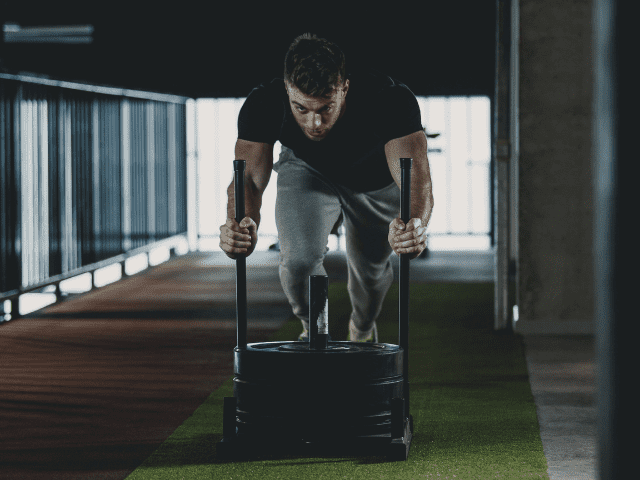
I wanted to finish off this list of Pistol Squat alternatives with an exercise that is a little outside the box. Prowler Pushes are good for a lot of things, and one of those things is building single-leg strength.
If you load a prowler rather heavy and march forward with the Prowler, you will cook your legs fast and build a ton of strength in the process.
Equipment Needed
- Prowler sled
- Bumper or iron plates
- At least a 20-yard stretch of turf
- Proper footwear. Shoes with a good grip or cleats (if turf is available) are ideal.
Step-By-Step Instruction
- Set your prowler in an area where you can push it at least 20 yards without hitting anything.
- Load the prowler with weight.
- Get behind the prowler and grab the high handle position.
- Hinge at the waist, bend the knees and extend your arms.
- Drive your legs and push the sled forward.
Coaching Points
The prowler push is a full-body movement. Keep the core tight, nice neutral spine, and keep those arms extended (Arms can be bent when focusing on heavier loads).
Focus on a strong knee drive and pushing through your feet to keep the prowler moving. Your body angle will be very similar to how you start a sprint. So the lower body action should be very similar to running.
A very important consideration here is the surface you are pushing on. Ideally, you are pushing the prowler on turf. This gives enough surface tension so that the prowler doesn’t glide or get stuck too easily. If you are pushing on a slicker surface like concrete or carpet, you may have to load more weight on the sled.
Final Thoughts
Pistol Squats are an amazing exercise and one of my favorite single-leg movements. However, I also understand why some would be intimidated by them.
Hopefully, this list has helped you figure out a Pistol Squat variation you can do or an alternative that can work in its place.

